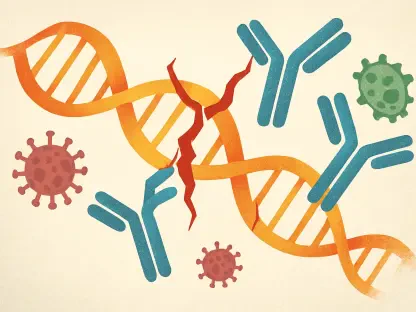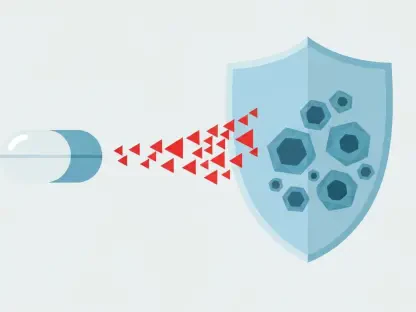Cancer metastasis remains one of the most challenging aspects of cancer treatment, significantly impacting patient survival rates. Recent research has shed light on the crucial role of the extracellular matrix (ECM) in influencing cancer cell behavior and metastasis. Understanding these interactions opens new avenues for therapeutic interventions aimed at preventing the spread of cancer.
The Role of the ECM in Cancer Progression
ECM as a Structural Scaffold
The ECM provides structural support to tissues, acting like scaffolding around a building. In the context of tumors, the ECM’s organization and composition can significantly influence cancer cell behavior. Researchers have discovered that cancer cells use the ECM as a guide to navigate and metastasize to other parts of the body. By providing a structural framework, the ECM not only supports the physical architecture of the tumor but also dictates the spatial arrangement and movement of cancer cells within it. This guidance allows cancer cells to migrate through the ECM, escape from the primary tumor, and establish secondary growths in distant organs, significantly complicating treatment strategies.
Variations in ECM Structure
The structure of the ECM varies within different regions of a tumor. In the tumor’s center, the ECM fibers are often disorganized, while at the edges, the fibers are densely packed and aligned. This alignment at the tumor’s border creates pathways that facilitate the outward movement of cancer cells, promoting metastasis. The disorganized fibers in the central region of the tumor may contribute to the chaotic environment that characterizes tumor growth. On the other hand, the densely packed and aligned fibers at the periphery provide directional cues for the cancer cells, effectively guiding them toward adjacent tissues and blood vessels, enabling their dissemination.
Impact on Cancer Cell Behavior
Cancer cells at the tumor’s border exhibit distinct physical and genetic changes compared to those in the center. These border cells tend to be more invasive and rounded, with gene expressions that enhance their migratory capabilities. Understanding these changes is crucial for developing targeted therapies to inhibit metastasis. The invasive nature of these cells is not only a result of their altered physical characteristics but also due to the genetic adaptations they undergo in response to the ECM’s structural cues. These adaptations make them more adept at degrading ECM components, squeezing through tight spaces, and surviving the harsh conditions of the metastatic journey.
Gene Expression and Cancer Cell Invasiveness
Specific Gene Expressions
Aggressive cancer cells at the tumor’s edge express genes linked to cell migration, inflammation, and ECM remodeling. These gene expressions are upregulated, making the cells more capable of invading surrounding tissues and spreading to distant sites. The upregulation of these genes also facilitates the production of enzymes that break down ECM components, creating space for cancer cells to move through and invade new areas. This gene expression pattern is indicative of a more aggressive phenotype that is specifically adapted to exploit the ECM’s structural features to enhance metastatic potential.
Experimental Evidence
Experimental models have shown that melanoma cells grown in ECM-like conditions consistent with the tumor border are more likely to metastasize. This evidence underscores the importance of the ECM’s structure in dictating cancer cell behavior and highlights potential targets for therapeutic intervention. By simulating the ECM conditions found at the tumor border, researchers have been able to observe firsthand how these conditions influence cancer cell behavior, providing valuable insights into the molecular mechanisms driving metastasis. These findings suggest that interventions aimed at disrupting these specific ECM conditions could be effective in preventing the spread of cancer.
Clinical Correlation
Higher expressions of specific genes in patient tumor samples correlate with poorer survival rates. This clinical relevance emphasizes the need for early identification of these aggressive cells and their characteristic changes to tailor more effective treatments. By correlating gene expression data with patient outcomes, researchers have been able to identify key genetic markers that predict metastasis and survival, providing valuable information for the development of personalized treatment plans. These insights could lead to the creation of diagnostic tests that identify patients at higher risk of metastasis, enabling earlier and more aggressive intervention strategies.
Potential for Early Intervention
Identifying Aggressive Cells
Early detection of aggressive cancer cells and their changes in gene expression can help clinicians develop more effective treatment strategies. By targeting these cells before they metastasize, it may be possible to improve patient outcomes significantly. Techniques such as liquid biopsies, which analyze circulating tumor DNA, could become valuable tools in identifying these aggressive cells at an early stage. This early intervention approach aims to halt the metastatic process before it fully takes hold, reducing the likelihood of secondary tumor formation and improving long-term survival rates.
Targeting ECM Components
Drugs that target ECM components, such as lysyl oxidase (LOX), show promise in inhibiting pathways that facilitate cancer cell migration and invasion. These therapies could potentially prevent metastasis, offering new hope for patients with aggressive cancers. By focusing on disrupting the ECM’s structural integrity and the signaling pathways it mediates, researchers are developing treatments that specifically target the metastatic process. These drugs could be used in conjunction with conventional therapies to provide a more comprehensive approach to cancer treatment, potentially improving outcomes for patients with high-risk tumors.
Broader Implications
The findings from this research are not limited to a single type of cancer. The mechanisms by which tumors exploit the ECM for metastasis appear to be universal across various cancer types. This broad applicability enhances the potential impact of ECM-targeted therapies in clinical settings. As researchers continue to explore the ECM’s role in different cancers, they are uncovering commonalities that could lead to the development of broad-spectrum anti-metastatic drugs. This universality increases the likelihood that new treatments will be effective across a wide range of cancers, making a significant impact on cancer care.
The Future of Cancer Treatment
Innovative Therapeutic Strategies
The insights gained from understanding the ECM’s role in cancer metastasis pave the way for innovative therapeutic strategies. By focusing on the interactions between cancer cells and the ECM, researchers can develop treatments that specifically target the pathways involved in metastasis. These novel therapies might include drugs that alter ECM composition, inhibit key enzymes involved in ECM remodeling, or block signaling pathways that promote cancer cell migration. By targeting the ECM, these strategies aim to disrupt the metastatic process at its source, reducing the spread of cancer and improving patient outcomes.
Improving Survival Rates
Preventing metastasis is key to improving survival rates for cancer patients. By inhibiting the mechanisms that allow cancer cells to spread, new treatments can significantly reduce cancer-related mortality and enhance the quality of life for patients. These treatments aim to address one of the most challenging aspects of cancer care—preventing the spread of the disease. By focusing on this critical aspect, researchers and clinicians hope to develop more effective treatment plans that not only extend survival but also improve the overall well-being of patients, offering them a better quality of life.
Ongoing Research
Cancer metastasis, the spread of cancerous cells from the original tumor to other parts of the body, remains one of the most formidable challenges in cancer treatment. This process considerably lowers patient survival rates and complicates effective treatment. Recent scientific discoveries have highlighted the vital importance of the extracellular matrix (ECM) in impacting how cancer cells behave and spread. The ECM, a network of proteins and other molecules surrounding cells, provides structural and biochemical support, influencing cancer cell migration and invasion. By understanding the complex interactions between cancer cells and the ECM, researchers aim to develop new therapeutic strategies that can potentially impede the metastatic process. These advancements hold the promise of improving patient outcomes by preventing the spread of cancer and enhancing the effectiveness of existing treatments. Consequently, the ongoing research into ECM and its role in cancer metastasis paves the way for innovative therapeutic interventions that could revolutionize cancer care and offer new hope to patients facing this devastating disease.









